Vanuatu
Five hundred miles to the west of Fiji is a group of 83 islands known as Vanuatu. It was previously called New Herbrides until it gained independence from the U.K and France in 1980. The Y-shaped group of islands supports primarily an agricultural society with more than eighty percent of the population growing food on traditionally owned land for personal consumption. The main island of Efate is the primary tourist destination with Espiritu Santo offering some of the best diving.
Featured World Adventure: Vanuatu -- Unexplored diving at its best
Enter the Remote Adventure of the Silent World
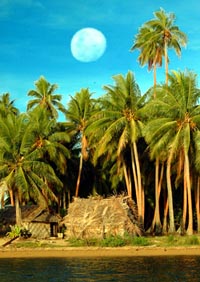 The flames and smoke of the distant volcano lights the warm evening horizon under a rising full moon. One can almost hear the phantom sounds of ancient cannibal drums over the quiet swaying of the waves against the Silent World dive boat. The South Pacific sky shimmers with moonlight over a remote corner of Vanuatu.
The flames and smoke of the distant volcano lights the warm evening horizon under a rising full moon. One can almost hear the phantom sounds of ancient cannibal drums over the quiet swaying of the waves against the Silent World dive boat. The South Pacific sky shimmers with moonlight over a remote corner of Vanuatu.
Five hundred miles to the west of Fiji is a group of 83 islands known as Vanuatu. It was previously called New Herbrides until it gained independence from the U.K and France in 1980. The Y-shaped group of islands supports primarily an agricultural society with more than eighty percent of the population growing food on traditionally owned land for personal consumption. The main island of Efate is the primary tourist destination with Espiritu Santo offering some of the best diving.
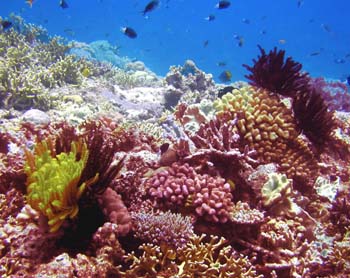 I first visited Vanuatu in the early 1990s to write a story about the land-based diving surrounding Santo. With the exception of the principal dive sites of the S.S. President Coolidge, Million Dollar Point and the Henry Bonneaud, diving was a well-kept secret with few operators not venturing far from Santo. My anticipation grew as I planned this second trip some ten years later. More than seeing the changes in the country and the main diving areas, I was excited about reaching and diving the outer islands onboard the Silent World.
I first visited Vanuatu in the early 1990s to write a story about the land-based diving surrounding Santo. With the exception of the principal dive sites of the S.S. President Coolidge, Million Dollar Point and the Henry Bonneaud, diving was a well-kept secret with few operators not venturing far from Santo. My anticipation grew as I planned this second trip some ten years later. More than seeing the changes in the country and the main diving areas, I was excited about reaching and diving the outer islands onboard the Silent World.
The landscape below the water is as dramatic as the lush tropical islands and volcanic mountains above. Plunging cliffs, lava tunnels and grottos form a wonderland abundant with life. Iridescent hard coral show far less damage than other parts of the South Pacific. Small but brightly colored gorgonian fans and outcrops of soft corals are found along walls and in the mouth of tunnels.
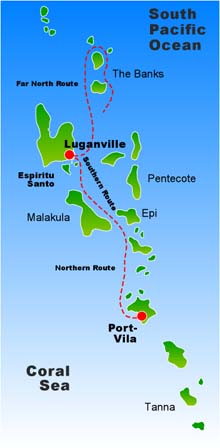 We flew Air Vanuatu from Fiji to Port Vila, the largest city in the country and the home port for the Silent World. Having served many functions over the years, including as a research vessel, the MV Silent One, a 100-foot ship, has been redesigned with a large dive deck providing ample space for "gearing up" and for photographers. The diving is directly off the dive deck or from Gemini tenders accessing the shallower reef areas.
We flew Air Vanuatu from Fiji to Port Vila, the largest city in the country and the home port for the Silent World. Having served many functions over the years, including as a research vessel, the MV Silent One, a 100-foot ship, has been redesigned with a large dive deck providing ample space for "gearing up" and for photographers. The diving is directly off the dive deck or from Gemini tenders accessing the shallower reef areas.
We settled into our small cabin, adequate for sleeping but not much else. There are 10 air-conditioned cabins with shared bathrooms. The gallery, dining area and lounge is an open-plan air-conditioned area an adequate size for eating, relaxing, studying and watching videos. The tight living quarters were more than compensated by the large dive deck and the open top deck. It is the location and excellent crew that makes the Silent World memorable.
The Silent World offers three trips: the Northern Route (Vila to Santo), the Southern Route (Santo to Vila) and the Far North (Santo to the Banks). The islands midway between Vila and Santo and the Banks can only be reached on the Silent World. They are the only dive live-aboard operating in Vanuatu and only began service in April of 2002. Our northern trip will take us past North Lamen, Maskelyne and
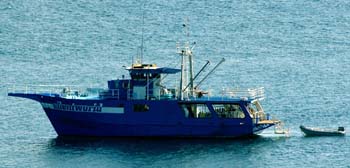 Sakau islands. The crew of the Silent World is just now opening up dive sites in these islands so it is possible to be the first to dive one of these remote sites. After a series of outstanding dives at Paul's Rock in Havannah Harbor and in Nguna Lava Tubes, we headed north to Lamen Island at the northern end of Epi Island. The reef has sloping contours with pristine hard corals and exceptional visibility. Lynn was amazed by the multitude of colors ranging from pastel pinks, lemon yellows, oranges and fluorescent blues. A night dive on this reef was by far one of the most exciting and critter-filled dives of the trip with mobile Tonne shells, free-swimming eels and a large crab giving birth.
Sakau islands. The crew of the Silent World is just now opening up dive sites in these islands so it is possible to be the first to dive one of these remote sites. After a series of outstanding dives at Paul's Rock in Havannah Harbor and in Nguna Lava Tubes, we headed north to Lamen Island at the northern end of Epi Island. The reef has sloping contours with pristine hard corals and exceptional visibility. Lynn was amazed by the multitude of colors ranging from pastel pinks, lemon yellows, oranges and fluorescent blues. A night dive on this reef was by far one of the most exciting and critter-filled dives of the trip with mobile Tonne shells, free-swimming eels and a large crab giving birth.
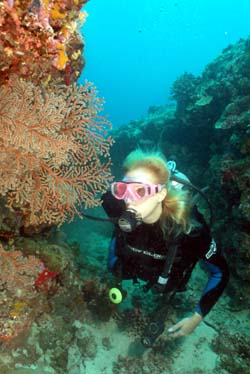 Further north lies the Maskelyne Islands situated on the southern tip of Malekula Island. In the distance looms Epi Island with a smoldering volcano. Here we made several dives on Fairway Reef. I was told that the dive site called Urabulbulah means "changer." The name comes from a folk story about an ancestor who changed into a turtle to come ashore. While on land, he turned into a goat and then a sea snake, then he returned to the reef.
Further north lies the Maskelyne Islands situated on the southern tip of Malekula Island. In the distance looms Epi Island with a smoldering volcano. Here we made several dives on Fairway Reef. I was told that the dive site called Urabulbulah means "changer." The name comes from a folk story about an ancestor who changed into a turtle to come ashore. While on land, he turned into a goat and then a sea snake, then he returned to the reef.
The reef literally changes with the tides. When the currents are strong, sharks, dogmouth tuna, bumphead parrotfish and other pelagics fill the waters reminiscent of Palau's famous Blue Corner. When the current was more slack, small things such as tiny shy hawkfish can be seen and photographed.
One of the highlights of the Maskelyne Islands is a special cultural tour to Rubin's Village. Named after the chief, Rubin opens his village only to the Silent World. Walking through the village, we are escorted by many children and visit homes where women are cooking outside.
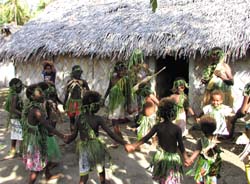 The village puts on a "Mele" which is a very special event with authentic food, dancing, music and singing. The dancers were dressed in grass-skirts and mud. A beautiful display of handicrafts and shells lay on mats for us to purchase. As we returned to the boat, a beautiful sunset followed by a radiant full moon.
The village puts on a "Mele" which is a very special event with authentic food, dancing, music and singing. The dancers were dressed in grass-skirts and mud. A beautiful display of handicrafts and shells lay on mats for us to purchase. As we returned to the boat, a beautiful sunset followed by a radiant full moon.
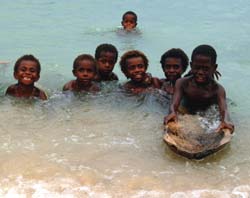 As it turned out, the Silent World's northern trip from Port Vila to Santo was an excellent choice because as you sharpen your diving skills you also build anticipation of the deep dives to the SS President Coolidge.
As it turned out, the Silent World's northern trip from Port Vila to Santo was an excellent choice because as you sharpen your diving skills you also build anticipation of the deep dives to the SS President Coolidge.
 Diving the Coolidge to see the "Lady," a large ceramic statue that resides deep within the confines, is a real experience. The 600-foot ship was sunk during WWII when it hit two U.S. mines that were supposed to protect them from Japanese submarines. Sitting on the slope only 300 feet from shore, it is the biggest, most accessible wreck dive in the world and one of the highlights of the Silent World adventure.
Diving the Coolidge to see the "Lady," a large ceramic statue that resides deep within the confines, is a real experience. The 600-foot ship was sunk during WWII when it hit two U.S. mines that were supposed to protect them from Japanese submarines. Sitting on the slope only 300 feet from shore, it is the biggest, most accessible wreck dive in the world and one of the highlights of the Silent World adventure.
We descended down a line to a hole in the starboard side where we enter the ship. The Lady was originally located in the main promenade requiring us to reach depths of 180 feet to view her. The Coolidge underwent some shifting and so she was moved up to a more accessible location. She now sits upright on the ceiling of a large room at only 130 feet! The Coolidge rests on her portside so the ceiling of the room appears as a wall in a narrow but very high corridor, adding to the already disorienting feeling of the deep penetration dive.
Another famous dive site is at Million Dollar Point. At the end of the Second World War the French and the Americans both occupied the island. An American General offered a French General all the surplus military equipment for less than 10 cents on the dollar. Knowing that the Americans could not afford to ship back any of the equipment, the General chose to wait for them to abandon the large vehicles. Rather than give it to the French, the American General ordered all the equipment to be driven into the sea. Today, this junkyard has become an underwater marine wonderland.
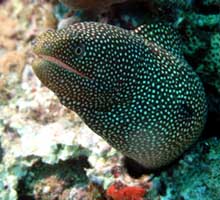 When taking any of the Silent World trips, plan to spend a couple of days on the island of Espiritu Santo. The DecoStop is a fine place to stay and eat while in Santo. Located on a hill overlooking the channel, the sweeping vistas afford a wonderful location to dine on the extended deck under tropical skies. There are several local dive operators to choose from and other fun-filled excursions.
When taking any of the Silent World trips, plan to spend a couple of days on the island of Espiritu Santo. The DecoStop is a fine place to stay and eat while in Santo. Located on a hill overlooking the channel, the sweeping vistas afford a wonderful location to dine on the extended deck under tropical skies. There are several local dive operators to choose from and other fun-filled excursions.
Golden Beach is a bit of a drive on the other side of the island but well worth the day's journey. Passing pastoral areas with small houses and villages, fruit stands and sleeping cattle, we descended a hill with blue-sparkling waters below. A small sign and wire-fence gate marks the rough road down to the beach. There we swam, sun-bathed and slept beneath the giant Tamanu trees. The fine yellow coral sand meets a turquoise sea with a gentle hypnotic sound. Tuku our driver awakes to take us to the Blue Hole where the groundwater-fed crystal-clear blue waters go all the way to the 50-foot bottom.
Returning by air from Espiritu Santo to Port Vila, we decided to spend a couple of days at the Hideaway Island Resort. Just outside of Vila is the landing were you can pick up a 2-minute water-taxi to the resort. Surrounded by coral reefs, clear water and thousands of fish, the Hideaway sits on a tiny coral atoll and is custodian to Vanuatu's only marine sanctuary.
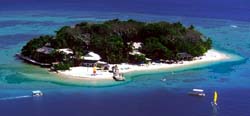 Coral reefs ideal for snorkelling or scuba diving are accessible right from the shore. The area is rich with fish, sponges, hard corals, anemones and gorgonian fans. The variety of dive sites includes steep walls down to 300 feet, lava flow caves and very photogenic coral reefs. This surprised us being so close to the country's largest city and International airport.
Coral reefs ideal for snorkelling or scuba diving are accessible right from the shore. The area is rich with fish, sponges, hard corals, anemones and gorgonian fans. The variety of dive sites includes steep walls down to 300 feet, lava flow caves and very photogenic coral reefs. This surprised us being so close to the country's largest city and International airport.
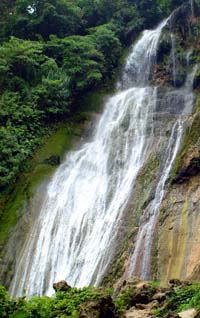 A short taxi ride from the landing is Mele Cascades Waterfall. An easy hike to the upper falls passes by many small pools, inviting a refreshing dip, which we did several times. This half-day tour is a must, but call ahead to find out if there are any large tourbuses, as this is a popular hike.
A short taxi ride from the landing is Mele Cascades Waterfall. An easy hike to the upper falls passes by many small pools, inviting a refreshing dip, which we did several times. This half-day tour is a must, but call ahead to find out if there are any large tourbuses, as this is a popular hike.
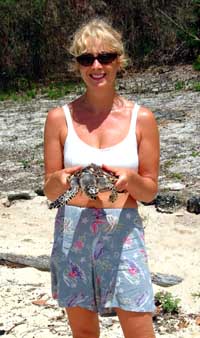 If you have an extra day, you can take the 75-foot classic timber sailing ketch, the Coongoola, for a cruise to the turtle conservation rookery and to some of the best and most remote fine white coral sand beaches in the area. The Tranquillity Island Turtle Project involves collecting eggs, hatching and raising them in salt-water tanks until they are large enough to be released. When they are about one or two years old, they are tagged and released on the beach. Lynn was selected to release a yearling Hawksbill turtle and was presented with a certificate with the turtle's tag number and the date of release. She awaits news of her turtle's return.
If you have an extra day, you can take the 75-foot classic timber sailing ketch, the Coongoola, for a cruise to the turtle conservation rookery and to some of the best and most remote fine white coral sand beaches in the area. The Tranquillity Island Turtle Project involves collecting eggs, hatching and raising them in salt-water tanks until they are large enough to be released. When they are about one or two years old, they are tagged and released on the beach. Lynn was selected to release a yearling Hawksbill turtle and was presented with a certificate with the turtle's tag number and the date of release. She awaits news of her turtle's return.
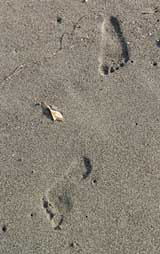 Vanuatu has yet to receive major attention from tourists and divers. It is one of the few dive destinations that is not overrun. You can still find white and black sand beaches there where the only footprints that are left are your own.
Vanuatu has yet to receive major attention from tourists and divers. It is one of the few dive destinations that is not overrun. You can still find white and black sand beaches there where the only footprints that are left are your own.
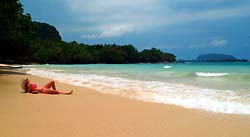 With so many islands, there are remote adventures yet to be experienced, such a the eight-day Silent World expedition to the "Banks" in the far north. In addition to diving, several other islands should not be missed as they offer cultural experiences rarely found in the world. The island of Pentecost is famous for the death-defying jump where natives bungee off self-constructed bamboo platforms. If their longhair touches the ground without killing them, the gods will favor the harvest.
With so many islands, there are remote adventures yet to be experienced, such a the eight-day Silent World expedition to the "Banks" in the far north. In addition to diving, several other islands should not be missed as they offer cultural experiences rarely found in the world. The island of Pentecost is famous for the death-defying jump where natives bungee off self-constructed bamboo platforms. If their longhair touches the ground without killing them, the gods will favor the harvest.
Other remote adventures include Tanna with its Yasur volcano that you can approach close enough to become part of the fire-shower. As the only diving live-aboard in Vanuatu, the Silent World can transport you to a world that has been left behind. Small villages that still rely on their gardens and the ocean with maybe electricity or battery-operated TV (they only get one local station), go about their daily routines much as they have done for hundreds of years.
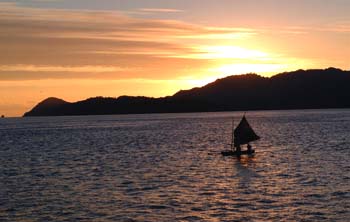 Most of the diving off the Silent World is not accessible any other way. Meyric Slimming, owner/partner, has lived in Vanuatu for many years. His part-Vanuatu crew, have opened the remote dive areas through developing relationships with local chiefs. The remainder of the crew are young, very able and energetic Australians who were the real gems of the trip. If you seek remote diving experiences in authentic South Pacific surroundings, Vanuatu and the Silent World is for you.
Most of the diving off the Silent World is not accessible any other way. Meyric Slimming, owner/partner, has lived in Vanuatu for many years. His part-Vanuatu crew, have opened the remote dive areas through developing relationships with local chiefs. The remainder of the crew are young, very able and energetic Australians who were the real gems of the trip. If you seek remote diving experiences in authentic South Pacific surroundings, Vanuatu and the Silent World is for you.
For additional information: Vanuatu Visitor's Information
